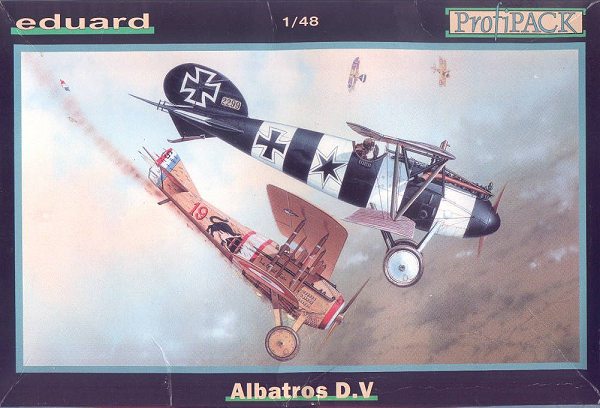
|
KIT: |
Eduard 1/48 Albatros D.V |
|
KIT # |
8110 |
|
PRICE: |
$29.95 |
|
DECALS: |
Four aircraft |
|
REVIEWER: |
|
|
NOTES: |
Multimedia kit with etched fret - Profipack version |

|
HISTORY |
While the Albatros D.V bids fair to win just about any contest for "Best-Looking Fighter of World War I," in fact this is the only way the last fighter product of the Albatros Werke Gmbh could take a first place. Technically, it was the least-successful of the line.
Albatros came into the fighter game in 1916 with its D.I and D.II biplanes, which were head-and-shoulders above their competition and set the standard for a modern fighter that has stood for 86 years: fast, agile, heavily-armed and able to outperform the competition. Unfortunately for the Albatros fighters, one of their more successful opponents was the Nieuport 17, a lightly-loaded, highly-maneuverable sesquiplane. Not all the laws of aerodynamics were fully known at the time, and the German authorities came to believe there was something inherent in the Nieuport design that made it successful, that something being the sesquiplane design. German manufacturers were ordered to develop sesquiplanes, Albatros among them.
The result was the Albatros D.III, which changed the strong biplane design for a sesquiplane, with the single spar in the lower wing. The Albatros design was different from the Nieuport - heavy where the Nieuport was light, and the sesquiplane was really not strong enough to perform under these kinds of loads. The Albatros D.III was a very good performer and became the standard German fighter by the Spring of 1917. However, it was not as maneuverable as its Nieuport and Sopwith competition.
The Albatros D.V was introduced that summer, a design that was very weight-conscious, and far lighter than the previous D.III. Unfortunately, it was structurally too light. The lower wing soon revealed its lack of strength when they began separating from the rest of the airframe in combat! This was the result of an unknown aerodynamic force - flutter - that overwhelmed the light attachment points of the lower wing under combat g-forces. Pilots began handling the airplane gingerly, and a fighter that has to be flown gingerly is not a winner. Albatros undertook to beef up the airframe, but all this did was add unnecessary weight without providing the requisite strength, and the Albatros D.V - though it served in large numbers and was still a significant fighter as late as the summer of 1918 - always fought with one hand behind its back. The killer of 1916 and 1917 was the prey by 1918.
All this is as may be, the Albatros D.V is one of the most aesthetically-pleasing designs to ever fly, and the colors its pilots flew it in make it a natural for modelers today.
|
THE KIT |
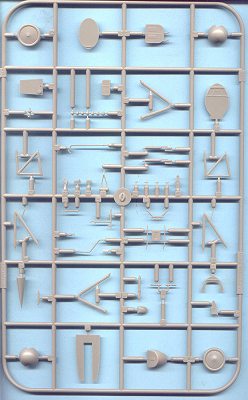 |
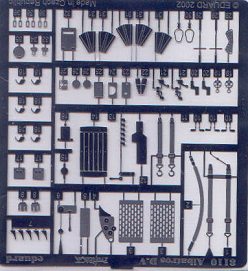 |
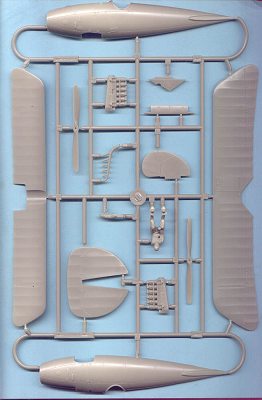 |
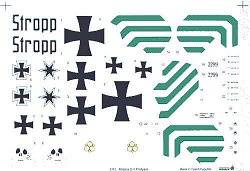 Eduard first introduced the Albatros D.V back in 1994, in the days of the
"limited-run" kit. The kit made up into a beautiful model, but it required work
to smooth the plastic parts and get rid of the flash, and all the detail parts
were done in the still-new photo-etch. While the basic kit was released in
several versions with different markings, it has been out of production now
since 1999.
Eduard first introduced the Albatros D.V back in 1994, in the days of the
"limited-run" kit. The kit made up into a beautiful model, but it required work
to smooth the plastic parts and get rid of the flash, and all the detail parts
were done in the still-new photo-etch. While the basic kit was released in
several versions with different markings, it has been out of production now
since 1999.
This is the first
"re-make" of an Eduard kit to the new standards introduced with the Sopwith
Triplane in 1998. Eduard no longer makes "limited run kits." Their products
are up to the quality level of any other mainstream producer, and ahead of
many. The new Albatros has a corrected landing gear, and has all basic airframe
parts - like the 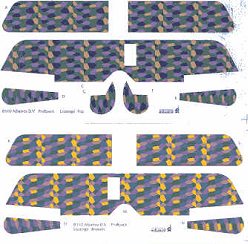 previously-photoetch
cabane struts - in injection-molded plastic. This is fully up to the quality
level of any recent Eduard kit, such as the Pfalz D.III series, the Roland C.II
or the Nieuport series.
previously-photoetch
cabane struts - in injection-molded plastic. This is fully up to the quality
level of any recent Eduard kit, such as the Pfalz D.III series, the Roland C.II
or the Nieuport series.
As a "Profipack" release, this particular kit does include photo-etch details such as seat belts, machine gun jackets, and small interior details, as well as four different sets of markings, along with Eduard "Express Masks" to make painting the model easier.
The four versions include the garish D.V flown by Herman Goering's buddy Bruno Loerzer that is on the box cover, the well-known "Stropp" - which sits today in the National Air and Space Museum - as well as a D.V. with black fuselage and lozenge wings flown by Ltn. Kissenberth of Jasta 23b, and Ltn. Georg von Hantelman's D.V from Jasta 15. All of these are good-looking schemes that will make up into a striking model.
My only complaint is that the lozenge decals that come with the kit do not look like any German lozenge I have ever seen, being very garish in their colors. While I am sure this will still allow a good-looking model to be created, I would strongly recommend that any modeler who desires to create an accurate model obtain either the new lozenge decals released by Eagle Strike - which are very good-looking - or lozenge from Americal-Gryphon, which may be a bit thick but is completely accurate. If lozenge is not for you (it is a complicated process to apply it), the Bruno Loerzer airplane uses the earlier mauve and green painted camouflage on the wings.
Overall, this is an easy kit to build of an important airplane, that will look great sitting on your shelves. Rigging on the Albatros series is not nearly so difficult as other World War I types.
Thanks to Eduard for the review copy.
If you would like your product reviewed fairly and quickly where it will be seen by well over 150,000 visitors a month, please contact me or see other details in the Note to Contributors.